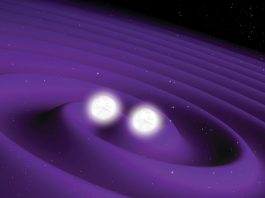Using data from NASA’s Fermi Space Telescope, an international research team found a neutron star rotating 377 times a second in an exotic binary system that emits mysterious gamma-ray pulsations.
The international collaboration used novel data analysis methods and the computing power of the citizen science project Einstein@Home to track down the neutron star’s faint gamma-ray pulsations. The team revealed that a rapidly rotating neutron star is at the core of a celestial object now known as PSR J2039−5617. Their results show that the pulsar is slowly evaporating its stellar companion, which is about a sixth of the mass of our Sun. The team also found that the companion’s orbit varies slightly and unpredictably over time.
The significance of Einstein@Home
The new research, published in Monthly Notices of the Royal Astronomical Society, details how the astronomer’s findings were boosted by the Einstein@Home project, a network of thousands of civilian volunteers lending their home computing power to the efforts of the Fermi Telescope’s work.
The group’s search required combing through the data to ensure that any possible signals were not missed. The Einstein@Home resources allowed for the study to be completed in two months, a process which would have taken 500 years if the team used a single computer core.
With the computing power donated by the Einstein@Home volunteers, the team discovered gamma-ray pulsations from the rapidly rotating neutron star. This gamma-ray pulsar, now known as J2039−5617, rotates about 377 times each second.
PSR J2039−5617’s background
J2039−5617 was discovered in 2014 and was known to be a source of X-rays, gamma rays, and light. All evidence obtained so far pointed at a rapidly rotating neutron star in orbit with a light-weight star at the heart of the source.
New observations of the stellar companion with optical telescopes provided precise data on the binary system without which a gamma-ray pulsar search (even with Einstein@Home’s huge computing power) would be unfeasible.
The new knowledge of the frequency of the gamma-ray pulsations also allowed collaborators to detect radio pulsations in archival data from the Parkes radio telescope. Their results, also published in Monthly Notices of the Royal Astronomical Society, show that the pulsar’s radio emission is often eclipsed by material that has been blown off the companion star by its nearby Redback pulsar.









